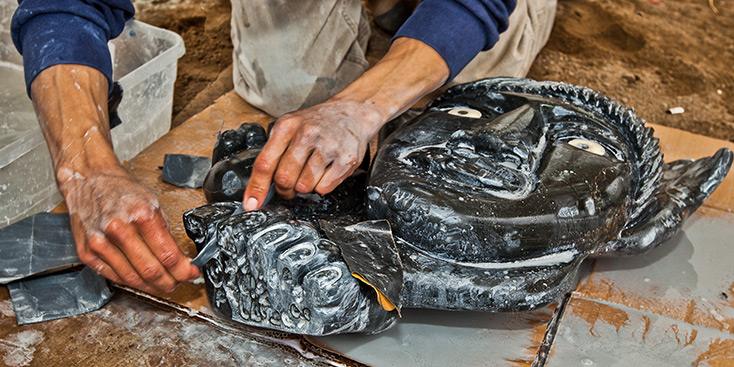Also known as 'Kinngait' in Inuktitut, this aboriginal artistic community is a main stop for arctic prowl ships.
Inhabited by native peoples for iii thousand years, Cape Dorset is situated on Dorset Island, adjacent to Foxe Peninsula at the southwestern tip of Baffin Isle.
It is world-renowned for the quality of the artwork produced by its visual artists. Blessed with breathtaking chill landscapes and an astonishing abundance of inspiring arctic wildlife, Dorset Isle and nearby Mallikjuaq Territorial Park are keen places to view, draw and photo migratory caribou, seabirds, whales, seals and walruses.
'Kinngait' is a popular destination for naturalists and art lovers who come up here each yr to feel the Inuit culture, to enjoy the treasures of the place and chat with the local artists.
Cape Dorset
ᑭᙵᐃᑦ
'Mountains'
Longitude xc° 51' W
Latitude 63° 22' North
Tiptop 8m
Cape Dorset is situated on an island where, at low tide, you can walk to the mainland. Dorset Island itself is fairly flat ground with some rolling hills.
Cape Dorset enjoys long sunny days from May through August with temperatures around 10°C on average, peaking at twenty°C occasionally.
Autumn weather is variable, ordinarily around 5°C, mostly sunny, but sometimes foggy with heavy rains. The snow begins to accumulate in November. The coldest months are January, February and March when the temperature can drib to –40°C. The snow normally starts to cook in April.
Current Weather in Cape Dorset
Greatcoat Dorset - 06 May
-5° -v°
-five°
Cape Dorset is the place where several archaeological sites of the aboriginal Dorset people (called 'Tuniit' or 'Sivullirmiut' in Inuktitut) were discovered that date back to 1000 BC. The more advanced Thule ancestors of the Inuit people somewhen displaced them.
The Vikings called them 'Skræling.' Like the ancient Norse seafaring people of Greenland, the Dorset people became extinct by 1500 Advertising. Even so, mystical traces of them all the same remain here today.
Cape Dorset was named so by the British explorer Luke Foxe, subsequently his sponsor Edward Sackville, the Earl of Dorset, in 1631. Before it was e'er called Cape Dorset, the local Inuit people had always known this unique location as 'Sikusiilaq' in Inuktitut, referring to the surface area of seawater nearby that remains ice-free all winter.
The Hudson Bay Company (HBC) founded a trading post hither in 1913.
In 1947, an HBC supply send chosen the RMS Nascopie ran ashore off the shores of Dorset Island. Before it sank completely, the resourceful local Inuit people salvaged its supplies and retrieved woods from the send to construct their homes.
At some point during the 1940s, the swell Inuit lensman Peter Pitseolak acquired his first camera here from a Catholic missionary.
northward 1957, the Canadian artist, writer and filmmaker James Archibald Houston (nicknamed 'Saumik' in Inuktitut, 'the left-handed 1') established a graphic arts workshop here. Its print program was modelled afterwards Japanese 'Ukiyo-e' (浮世絵 —'pictures of the floating earth') workshops. This art studio experimented with carving, engraving, lithography and silkscreen printmaking techniques.
Between 1959 and 1974, Cape Dorset artists produced more than than 48,000 limited edition prints. Famous artists from Cape Dorset include Pudlo Pudlat and Kenojuak Ashevak. Canadian postage stamp stamps and a Canadian quarter (25 cent piece) have featured Ashevak'south distinctive drawings of snowy owls.
Dorset Island and nearby Mallikjuaq Island waters and fertile terrain back up many forms of arctic wild animals, including herds of caribou and walrus, pods of seals and beluga whales, occasionally a migrating bowhead whale passing by and sometimes a wandering polar carry or two.
The well-trodden trails of Dorset Isle and Mallikjuaq Island volition have yous to these special wildlife-viewing sites. Visitors bask trekking through the rolling hills to secluded waterfalls and crystalline lakes, pausing sometimes in ancient coastal places to sit in the brilliant sunshine and scout ice floes slowly drifting by.
After hiking, boating, skiing, snowmobiling or domestic dog sledding, a visit to 'Kinngait' would not be consummate without besides experiencing its potent visual arts scene!
In July, when wildflowers dapple the tundra valleys with vivid colours, when seabirds render for their nesting season, the local people will travel to hunting camps situated along the nearby shorelines, equally they have done for centuries.
Cape Dorset is world-famous for its great artworks.
Printmaking, drawing and carving are the primary economic activities here. Founded in 1959, the Westward Baffin Eskimo Co-operative is the best venue to view these beautiful works and meet with the famed artists themselves. Kinngait Studios, which business firm the co-op's graphic arts program, produce a highly acclaimed impress collection each year. Cape Dorset is fondly known locally equally the true 'Capital letter of Inuit Art.'
It has justifiably been called the nearly artistic community in Canada, with some 22% of its labour forcefulness employed in the visual arts.
Due west Baffin Eskimo Co-operative Express
Mallikjuaq Territorial Park
Mallikjuaq means 'big wave' in Inuktitut, an advisable name for an island where rounded rock hills and depression tundra valleys resemble behemothic rolling waves. While magical Mallikjuaq Territorial Park gets its name from its gentle topography, its mystical spirit comes from its eternal wild fauna and ancient human history. Located a mere forty-five minute walk from Cape Dorset, here in this park you lot will observe a host of ancient Dorset archaeological sites, with rock structures dating dorsum three millennia.
It is a special place of cracking solace and natural dazzler.
Mallikjuaq Park Visitor Centre
Offices of the Hamlet of Cape Dorset
doritygetured1989.blogspot.com
Source: https://travelnunavut.ca/regions-of-nunavut/communities/cape-dorset/


0 Response to "James Houston Armchair Tourism and the Marketing of Inuit Art"
ارسال یک نظر